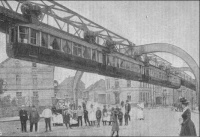
The Schwebebahn Wuppertal, literally translated as the ’Floating Railway of Wuppertal’, is one of the most unique public transport systems in the world. It is a suspended railway that travels 13.3km over the river Wupper between the districts of Oberbarmen and Vohwinkel in Germany.
The system, which has been operating for more than 100 years, was based on a design conceived by British engineer Henry Palmer.
In 1824, Palmer presented a railway system on which suspended carriages were drawn by horses. Friedrich Harkort, a German industrialist and politician, loved the idea and had a system of this type built as a trial in Elberfeld.
The town’s councillors opposed the plan and the suspended railway was instead built by Eugen Langen in Cologne during the 1880s. In 1901, after a construction period of three years, the suspended railway came into operation in Wuppertal.
The Engineer reported on the details of the design: ’The longitudinal track girders deliver their whole load on the upper surfaces of the top cross girders of the rocking and anchored arches. A normal gird weights 21.5 tons, and the weight of the two fully loaded trains, each of two cars, is 63 tons.
’When the Barmen section is thrown open to traffic this autumn it is intended to run four-car trains. These developments will increase the train load to about 100 tons at most, there being hardly room for three.’
The railway survived the Second World War and operated for 98 years before recording its first fatal accident. The design, however, never caught on more widely.










WildFusion helps robot traverse difficult terrain
<a...